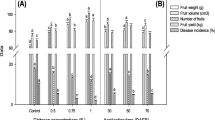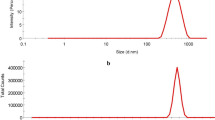Abstract
Consumption of leafy vegetables is highly recommended for meeting dietary requirements for antioxidants, vitamins, and minerals. However, the short shelf life of leaves often compromises the nutritional contents and causes economic loss for farmers and sellers. Chitosan, a natural polymer obtained from seafood waste, has been proposed to improve plant qualities in the postharvest condition. In this study, the quality of spinach leaves following chitosan treatments was analyzed to test the capacity of chitosan to improve postharvest management of spinach. Specifically, harvested spinach leaves were dipped in distilled water, 1% (v/v) acetic acid, and 0.1 and 0.5% (w/v) chitosan. The leaves were then examined for morphological, physiological, and molecular parameters following each treatment on days 0 and 3 after incubation at room temperature with a 12/12-h photoperiod. Our results suggested that the application of 0.1% (w/v) chitosan solution to postharvest spinach delayed the decaying process, possibly due to the suppression of bacterial growth. The elicitation mechanism by chitosan involved proline accumulation, retaining chlorophyll, increasing expression of antioxidant genes (Cu/Zn-SOD and CAT), and decreasing ROS (O2− and H2O2) content. In conclusion, our results support the suggested role of chitosan treatment in maintaining quality of postharvest spinach by regulating the elicitation processes and limiting bacterial growth.





Similar content being viewed by others
References
Adiletta G, Pasquariello MS, Zampella L, Mastrobuoni F, Scortichini M, Petriccione M (2018) Chitosan coating: a Postharvest treatment to delay oxidative stress in loquat fruits during cold storage. Agronomy 8:5–10. https://doi.org/10.3390/agronomy8040054
Altschul SF, Gish W, Miller W, Myers EW, Lipman DJ (1990) Basic local alignment search tool. J Mol Biol 215:403–410. https://doi.org/10.1016/S0022-2836(05)80360-2
Asada K (2006) Production and scavenging of reactive oxygen species in chloroplasts and their functions. Plant Physiol 141:391–396. https://doi.org/10.1104/pp.106.082040
Babic I, Roy S, Watada AE, Wergin WP (1996) Changes in microbial populations on fresh cut spinach. Int J Food Microbiol 31:107–119. https://doi.org/10.1016/0168-1605(96)00969-5
Bates LS, Waldren RP, Teare ID (1973) Rapid determination of free proline for water-stress studies. Plant Soil 207:205–207. https://doi.org/10.1007/BF00018060
Betchem G, Johnson NAN, Wang Y (2019) The application of chitosan in the control of post-harvest diseases: a review. J Plant Dis Prot 126:495–507. https://doi.org/10.1007/s41348-019-00248-2
Bhat KA, Masood SD, Bhat NA, Bhat MA, Razvi SM, Mir MR, Akhtar S, Wani N, Habib M (2010) Current status of post harvest soft rot in vegetables: a review. Asian J Plant Sci 9:200–208. https://doi.org/10.3923/ajps.2010.200.208
Blakeney M (2019) Food loss and food waste: causes and solutions, Cheltenham, UK. https://doi.org/10.4337/9781788975391
Cecchini NM, Monteoliva MI, Alvarez ME (2011) Proline dehydrogenase contributes to pathogen defense in arabidopsis. Plant Physiol 155:1947–1959. https://doi.org/10.1104/pp.110.167163
Das K, Roychoudhury A (2014) Reactive oxygen species (ROS) and response of antioxidants as ROS-scavengers during environmental stress in plants. Front Environ Sci 2:1–13. https://doi.org/10.3389/fenvs.2014.00053
Emami BZ, Siadat SA, Bakhshandeh A, Ghasemi Pirbalouti A, Hashemi M (2017) Interactive effects of drought stress and chitosan application on physiological characteristics and essential oil yield of Thymus daenensis Celak. Crop J 5:407–415. https://doi.org/10.1016/j.cj.2017.04.003
Esyanti RR, Dwivany FM, Mahani S, Nugrahapraja H, Meitha K (2019) Foliar application of chitosan enhances growth and modulates expression of defense genes in chilli pepper (Capsicum annuum L.). Aust J Crop Sci 13:55–60. https://doi.org/10.21475/ajcs.19.13.01.p1169
Food Sustainability Index (2020) Food Sustainbility Index. Econ Newsp Ltd. https://foodsustainability.eiu.com/country-ranking/. Accessed 10 November 2020
Forlani G, Trovato M, Funck D, Signorelli S (2019) Regulation of proline accumulation and its molecular and physiological functions in stress defence. Osmoprotectant-mediated abiotic stress toler plants. Recent Adv Futur Perspect. Springer, New York, pp 73–97. https://doi.org/10.1007/978-3-030-27423-8_3
Fortunati E, Giovanale G, Luzi F, Mazzaglia A, Kenny JM, Torre L, Balestra GM (2017) Effective postharvest preservation of kiwifruit and romaine lettuce with a chitosan hydrochloride coating. Coatings 7:1–11. https://doi.org/10.3390/coatings7110196
Ghasemnezhad M, Nezhad M, Gerailoo S (2011) Changes in postharvest quality of loquat (Eriobotrya japonica). Hortic Environ Biotechnol 52:40–45. https://doi.org/10.1007/s13580-011-0028-5
Groten K, Vanacker H, Duttilleul C, Bastian F, Bernard S, Carzaniga R, Foyer CH (2005) The roles of redox processes in pea nodule development and senescence. Plant Cell Environ 28:1293–1304. https://doi.org/10.1111/j.1365-3040.2005.01376.x
Hadwiger LA (2013) Plant science review: multiple effects of chitosan on plant systems: Solid science or hype. Plant Sci 208:42–49. https://doi.org/10.1016/j.plantsci.2013.03.007
Holcroft D (2015) Water relations in harvested fresh produce. Postharvest Educ Found White Pap [Internet]. 15:1–16. https://www.postharvest.ucdavis.edu
Hoque MA, Banu MNA, Okuma E, Amako K, Nakamura Y, Shimoishi Y, Murata Y (2007) Exogenous proline and glycinebetaine increase NaCl-induced ascorbate-glutathione cycle enzyme activities, and proline improves salt tolerance more than glycinebetaine in tobacco Bright Yellow-2 suspension-cultured cells. J Plant Physiol 164:1457–1468. https://doi.org/10.1016/j.jplph.2006.10.004
Hoque MA, Banu MNA, Nakamura Y, Shimoishi Y, Murata Y (2008) Proline and glycinebetaine enhance antioxidant defense and methylglyoxal detoxification systems and reduce NaCl-induced damage in cultured tobacco cells. J Plant Physiol 166:813–824. https://doi.org/10.1016/j.jplph.2007.07.013
Islam MM, Hoque MA, Okuma E, Banu MNA, Shimoishi Y, Nakamura Y, Murata Y (2009) Exogenous proline and glycinebetaine increase antioxidant enzyme activities and confer tolerance to cadmium stress in cultured tobacco cells. J Plant Physiol 166:1587–1597. https://doi.org/10.1016/j.jplph.2009.04.002
Jiao Z, Li Y, Li J, Xu X, Li H, Lu D, Wang J (2012) Effects of exogenous chitosan on physiological characteristics of potato seedlings under drought stress and rehydration. Potato Res 55:293–301. https://doi.org/10.1007/s11540-012-9223-8
Kase JA, Borenstein S, Blodgett RJ, Feng PCH (2012) Microbial quality of bagged baby spinach and romaine lettuce: effects of top versus bottom sampling. J Food Prot 75:132–136. https://doi.org/10.4315/0362-028X.JFP-11-097
Kaushal N, Gupta K, Bhandhari K, Kumar S, Thakur P, Nayyar H (2011) Proline induces heat tolerance in chickpea (Cicer arietinum L.) plants by protecting vital enzymes of carbon and antioxidative metabolism. Physiol Mol Biol Plants 17:203–213. https://doi.org/10.1007/s12298-011-0078-2
Kim HJ, Chen F, Wang X, Rajapakse NC (2005) Effect of chitosan on the biological properties of sweet basil (Ocimum basilicum L.). J Agric Food Chem 53:3696–3701. https://doi.org/10.1021/jf0480804
Limpanavech P, Chaiyasuta S, Vongpromek R, Pichyangkura R, Khunwasi C, Chadchawan S, Lotrakul P, Bunjongrat R, Chaidee A, Bangyeekhun T (2008) Chitosan effects on floral production, gene expression, and anatomical changes in the Dendrobium orchid. Sci Hortic 116:65–72. https://doi.org/10.1016/j.scienta.2007.10.034
Livak KJ, Schmittgen TD (2001) Analysis of relative gene expression data using Real-Time Quantitative PCR and the 2 – ∆∆CT method. Methods 25:402–408. https://doi.org/10.1006/meth.2001.1262
Mondal MMA, Rana MIK, Dafader NC, Haque ME (2011) Effect of foliarapplication of chitosan on growth and yield in Indian spinach. J Agrofor Environ 5:99–102
Moreira M, Roura R, Ponce SI A (2011) Effectiveness of chitosan edible coatings to improve microbiological and sensory quality of fresh cut broccoli. LWT - Food Sci Technol 44:2335–2341. https://doi.org/10.1016/j.lwt.2011.04.009
Muymas R, Pichyangkura W, Wiriyakitnateekul T, Wangsomboondee S, Chadchawan, Seraypheap K (2015) Effects of chitin-rich residues on growth and postharvest quality of lettuce. Biol Agric Hortic 31:108–117. https://doi.org/10.1080/01448765.2014.974669
Pandey P, Bala N (2016) Enumeration of microbial load in leafy vegetables grown in periphery of Allahabad District, Up, India. Int J Adv Res 4:1283–1291. https://doi.org/10.21474/ijar01/2213
Pichyangkura R, Chadchawan S (2015) Biostimulant activity of chitosan in horticulture. Sci Hortic 196:49–65. https://doi.org/10.1016/j.scienta.2015.09.031
Rawtherapee (2009) Rawtherapee: Image processing program. http://www.rawtherapee.com. Accessed 20 December 2020
RCore (2020) R: a language and environment for statistical computing
Rejeb K, Lefebvre-De Vos D, Le Disquet I, Leprince AS, Bordenave M, Maldiney R, Jdey A, Abdelly C, Savouré A (2015) Hydrogen peroxide produced by NADPH oxidases increases proline accumulation during salt or mannitol stress in Arabidopsis thaliana. New Phytol 208:1138–1148. https://doi.org/10.1111/nph.13550
Romanazzi G, Feliziani E, Sivakumar D (2018) Chitosan, a biopolymer with triple action on postharvest decay of fruit and vegetables: eliciting, antimicrobial and film-forming properties. Front Microbiol 9:2745. https://doi.org/10.3389/fmicb.2018.02745
Schneider CA, Rasband WS, Eliceiri KW (2012) NIH Image to ImageJ: 25 years of image analysis. Nat Methods 9:671–675. https://doi.org/10.1038/nmeth.2089
Sharma S, Villamor JG, Verslues PE (2011) Essential role of tissue-specific proline synthesis and catabolism in growth and redox balance at low water potential. Plant Physiol 157:292–304. https://doi.org/10.1104/pp.111.183210
Signorelli S (2016) The fermentation analogy: a point of view for understanding the intriguing role of proline accumulation in stressed plants. Front Plant Sci 7:1–6. https://doi.org/10.3389/fpls.2016.01339
Signorelli S, Monza J (2017) Identification of ∆1-pyrroline 5-carboxylate synthase (P5CS) genes involved in the synthesis of proline in Lotus japonicus. Plant Signal Behav 12:1–11. https://doi.org/10.1080/15592324.2017.1367464
Signorelli S, Coitiño EL, Borsani O, Monza J (2014) Molecular mechanisms for the reaction between •OH radicals and proline: insights on the role as reactive oxygen species scavenger in plant stress. J Phys Chem B 118:37–47. https://doi.org/10.1021/jp407773u
Signorelli S, Dans PD, Coitiño EL, Borsani O, Monza J (2015) Connecting proline and γ-aminobutyric acid in stressed plants through non-enzymatic reactions. PLoS One 10:1–14. https://doi.org/10.1371/journal.pone.0115349
Slavin JL, Lloyd B (2012) Health benefits of fruits and vegetables. Am Soc Nutr 3:506–516. https://doi.org/10.3945/an.112.002154.506
Soendjojo E (2012) Is Local Produce Safer? Microbiological quality of fresh lettuce and spinach from grocery stores and farmers’ markets. J Purdue Undergrad Res 2:54–63. https://doi.org/10.5703/jpur.02.1.09
Szabados L, Savouré A (2010) Proline: a multifunctional amino acid. Trends Plant Sci 15:89–97. https://doi.org/10.1016/j.tplants.2009.11.009
Vieira JM, Flores-López ML, de Rodríguez DJ, Sousa MC, Vicente AA, Martins JT (2016) Effect of chitosan-Aloe vera coating on postharvest quality of blueberry (Vaccinium corymbosum) fruit. Postharvest Biol Technol 116:88–97. https://doi.org/10.1016/j.postharvbio.2016.01.011
Waszczak C, Carmody M, Kangasjärvi J (2018) Reactive oxygen species in plant signaling. Annu Rev Plant Biol 69:209–236. https://doi.org/10.1146/annurev-arplant-042817-040322
Xing K, Zhu X, Peng X, Qin S (2014) Chitosan antimicrobial and eliciting properties for pest control in agriculture: a review. Agron Sustain Dev 35:569–588. https://doi.org/10.1007/s13593-014-0252-3
Xing Y, Xu Q, Li X, Chen C, Ma L, Li S, Che Z, Lin H (2016) Chitosan-based coating with antimicrobial agents: preparation, property, mechanism, and application effectiveness on fruits and vegetables. Int J Polym Sci 2016:73-90. https://doi.org/10.1155/2016/4851730
Yoshiba Y, Kiyosue T, Nakashima K, Yamaguchi-Shinozaki K, Shinozaki K (1997) Regulation of levels of proline as an osmolyte in plants under water stress. Plant Cell Physiol 38:1095–1102. https://doi.org/10.1093/oxfordjournals.pcp.a029093
Youwel Y, Yinzhe R (2013) Effect of chitosan coating on preserving character of post-harvest fruit and vegetable: a review. J Food Process Technol 4:1–3. https://doi.org/10.4172/2157-7110.1000254
Zhang D, Quantick PC (1997) Effects of chitosan coating on enzymatic browning and decay during postharvest storage of litchi (Litchi chinensis Sonn.) fruit. Postharvest Biol Technol 12:195–202. https://doi.org/10.1016/S0925-5214(97)00057-4
Zheng F, Zheng W, Li L, Pan S, Liu M, Zhang W, Liu H, Zhu C (2017) Chitosan controls postharvest decay and elicits defense response in kiwifruit. Food Bioprocess Technol 10:1937–1945. https://doi.org/10.1007/s11947-017-1957-5
Acknowledgements
The authors would like to thank the Institute for Research and Community Services of ITB (LPPM-ITB) for the P3MI 2019 grant to KM.
Author information
Authors and Affiliations
Contributions
Authors have contributed to this work in following roles: Conceptualization, KM, SS; Methodology, KM, YP, SS, JAK; Formal Analysis, KM, YP, JAK; Writing-Original Draft Preparation, KM, YP, SS, JAK; Writing-Review & Editing, KM, YP, SS; Visualization, KM, YP, SS; Funding Acquisition, KM.
Corresponding author
Ethics declarations
Conflict of interest
The authors have no conflict of interests to declare.
Additional information
Communicated by Jinwook Lee.
Publisher’s Note
Springer Nature remains neutral with regard to jurisdictional claims in published maps and institutional affiliations.
Rights and permissions
About this article
Cite this article
Meitha, K., Pramesti, Y., Signorelli, S. et al. Postharvest chitosan application maintains the quality of spinach through suppression of bacterial growth and elicitation. Hortic. Environ. Biotechnol. 63, 217–227 (2022). https://doi.org/10.1007/s13580-021-00397-0
Received:
Revised:
Accepted:
Published:
Issue Date:
DOI: https://doi.org/10.1007/s13580-021-00397-0




